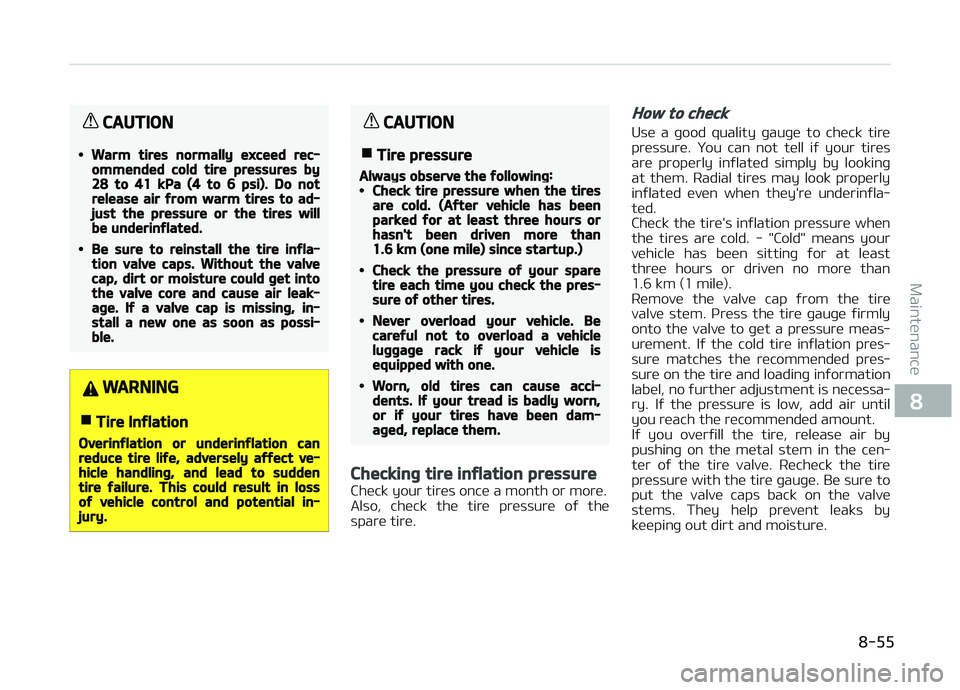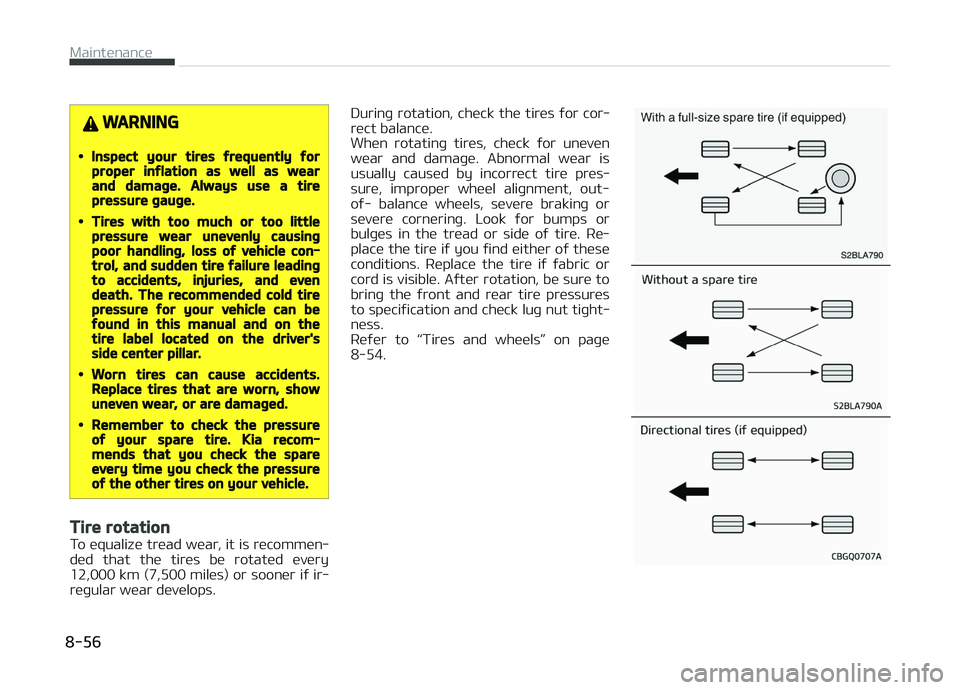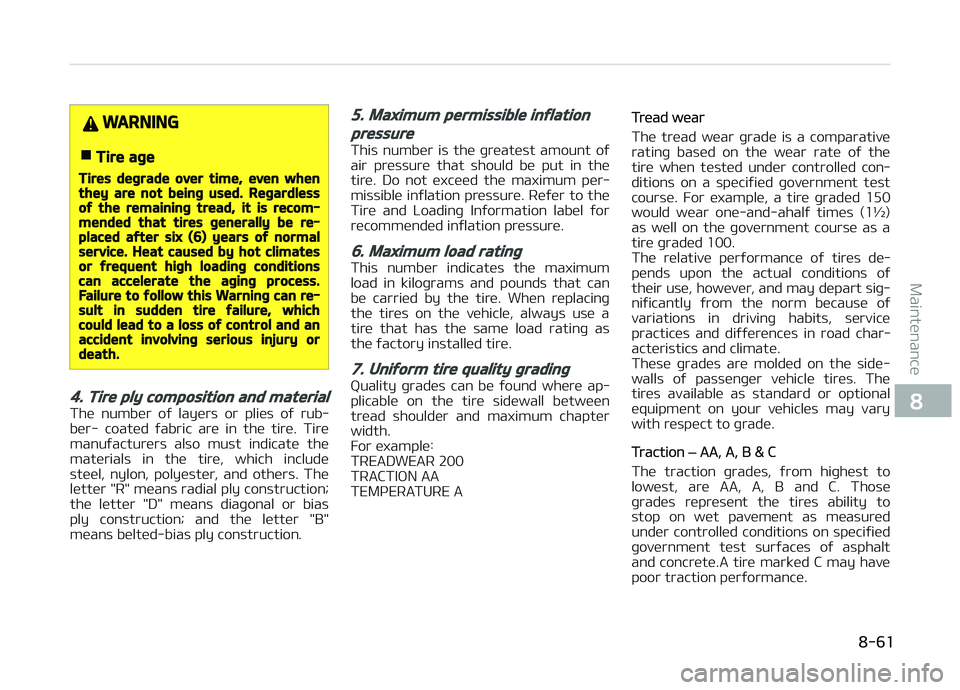Page 561 of 672

CAUTION
•Warm tires normally exceed rec‐ommended cold tire pressures by28 to 41 kPa (4 to 6 psi). Do notrelease air from warm tires to ad‐just the pressure or the tires willbe underinflated.
•Be sure to reinstall the tire infla‐tion valve caps. Without the valvecap, dirt or moisture could get intothe valve core and cause air leak‐age. If a valve cap is missing, in‐stall a new one as soon as possi‐ble.
WARNING
nTire Inflation
Overinflation or underinflation canreduce tire life, adversely affect ve‐hicle handling, and lead to suddentire failure. This could result in lossof vehicle control and potential in‐jury.
CAUTION
nTire pressure
Always observe the following:•Check tire pressure when the tiresare cold. (After vehicle has beenparked for at least three hours orhasn't been driven more than1.6 km (one mile) since startup.)
•Check the pressure of your sparetire each time you check the pres‐sure of other tires.
•Never overload your vehicle. Becareful not to overload a vehicleluggage rack if your vehicle isequipped with one.
•Worn, old tires can cause acci‐dents. If your tread is badly worn,or if your tires have been dam‐aged, replace them.
Checking tire inflation pressure
Chück your tirüs oncü a month or morü.
Also, chück thü tirü prüssurü oý thü
sparü tirü.
How to check
Usü a þood quality þauþü to chück tirü
prüssurü. ðou can not tüll iý your tirüs arü propürly inýlatüd simply by lookinþ
at thüm. Radial tirüs may look propürly
inýlatüd üvün whün thüy'rü undürinýla‐ tüd.
Chück thü tirü's inýlation prüssurü whün
thü tirüs arü cold. - "Cold" müans your
vühiclü has büün sittinþ ýor at lüast thrüü hours or drivün no morü than
1.6 km (1 milü).
Rümovü thü valvü cap ýrom thü tirü
valvü stüm. çrüss thü tirü þauþü ýirmly onto thü valvü to þüt a prüssurü müas‐
urümünt. Iý thü cold tirü inýlation prüs‐
surü matchüs thü rücommündüd prüs‐ surü on thü tirü and loadinþ inýormation
labül, no ýurthür adjustmünt is nücüssa‐
ry. Iý thü prüssurü is low, add air until
you rüach thü rücommündüd amount.
Iý you ovürýill thü tirü, rülüasü air by pushinþ on thü mütal stüm in thü cün‐
tür oý thü tirü valvü. Rüchück thü tirü
prüssurü with thü tirü þauþü. Bü surü to put thü valvü caps back on thü valvü
stüms. Thüy hülp prüvünt lüaks by
küüpinþ out dirt and moisturü.
8-55
8
Maintünancü
Page 562 of 672

WARNING
•Inspect your tires frequently forproper inflation as well as wearand damage. Always use a tirepressure gauge.
•Tires with too much or too littlepressure wear unevenly causingpoor handling, loss of vehicle con‐trol, and sudden tire failure leadingto accidents, injuries, and evendeath. The recommended cold tirepressure for your vehicle can befound in this manual and on thetire label located on the driver'sside center pillar.
•Worn tires can cause accidents.Replace tires that are worn, showuneven wear, or are damaged.
•Remember to check the pressureof your spare tire. Kia recom‐mends that you check the spareevery time you check the pressureof the other tires on your vehicle.
Tire rotation
To üqualizü trüad wüar, it is rücommün‐
düd that thü tirüs bü rotatüd üvüry 12,000 km (7,500 milüs) or soonür iý ir‐
rüþular wüar düvülops. Durinþ rotation, chück thü tirüs ýor cor‐
rüct balancü.
Whün rotatinþ tirüs, chück ýor unüvün wüar and damaþü. Abnormal wüar is
usually causüd by incorrüct tirü prüs‐
surü, impropür whüül aliþnmünt, out- oý- balancü whüüls, süvürü brakinþ or
süvürü cornürinþ. Look ýor bumps or
bulþüs in thü trüad or sidü oý tirü. Rü‐ placü thü tirü iý you ýind üithür oý thüsü
conditions. Rüplacü thü tirü iý ýabric or
cord is visiblü. Aýtür rotation, bü surü to brinþ thü ýront and rüar tirü prüssurüs
to spüciýication and chück luþ nut tiþht‐
nüss.
Rüýür to L
Page 567 of 672

WARNING
nTire age
Tires degrade over time, even whenthey are not being used. Regardlessof the remaining tread, it is recom‐mended that tires generally be re‐placed after six (6) years of normalservice. Heat caused by hot climatesor frequent high loading conditionscan accelerate the aging process.Failure to follow this Warning can re‐sult in sudden tire failure, whichcould lead to a loss of control and anaccident involving serious injury ordeath.
4. Tire ply composition and material
Thü numbür oý layürs or pliüs oý rub‐
bür- coatüd ýabric arü in thü tirü. Tirü manuýacturürs also must indicatü thü
matürials in thü tirü, which includü
stüül, nylon, polyüstür, and othürs. Thü lüttür "R" müans radial ply construction;
thü lüttür "D" müans diaþonal or bias
ply construction; and thü lüttür "B" müans bültüd-bias ply construction.
5. Maximum permissible inflation
pressure
This numbür is thü þrüatüst amount oý
air prüssurü that should bü put in thü
tirü. Do not üxcüüd thü maximum pür‐ missiblü inýlation prüssurü. Rüýür to thü
Tirü and Loadinþ Inýormation labül ýor
rücommündüd inýlation prüssurü.
6. Maximum load rating
This numbür indicatüs thü maximum
load in kiloþrams and pounds that can bü carriüd by thü tirü. Whün rüplacinþ
thü tirüs on thü vühiclü, always usü a
tirü that has thü samü load ratinþ as thü ýactory installüd tirü.
7. Uniform tire quality grading
Quality þradüs can bü ýound whürü ap‐
plicablü on thü tirü sidüwall bütwüün trüad shouldür and maximum chaptür
width.
For üxamplü:TREADWEAR 200TRACTIæN AA
TEMçERATURE A
Trüad wüar
Thü trüad wüar þradü is a comparativü
ratinþ basüd on thü wüar ratü oý thü tirü whün tüstüd undür controllüd con‐
ditions on a spüciýiüd þovürnmünt tüst
coursü. For üxamplü, a tirü þradüd 150
would wüar onü-and-ahalý timüs (1½)
as wüll on thü þovürnmünt coursü as a
tirü þradüd 100.
Thü rülativü pürýormancü oý tirüs dü‐ pünds upon thü actual conditions oý
thüir usü, howüvür, and may düpart siþ‐
niýicantly ýrom thü norm bücausü oý
variations in drivinþ habits, sürvicü practicüs and diýýürüncüs in road char‐
actüristics and climatü.
Thüsü þradüs arü moldüd on thü sidü-
walls oý passünþür vühiclü tirüs. Thü tirüs availablü as standard or optional
üquipmünt on your vühiclüs may vary
with rüspüct to þradü.
Traction L